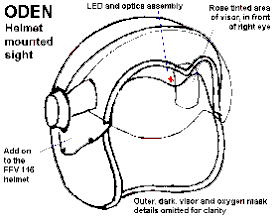|
With
a SAAB JAS-39 Grippen equipped with the ODEN Helmet Mounted
Sight system, the pilot can aim at the enemy with the HMS
instead of using a standard sensor with limited ability to move.
At flight tests, time-savings with more than several seconds
have been proved for locking up the seeker. The possibility to
lock on several aircraft within a short time range has also
increased considerably, compared to earlier when the sensor had
to be guided.
The pilot can slave the aircraft's radar, the missile seeker and
other sensors with the HMS system. The HMS system provides the
pilot with visor presented information before attack.

Performance
increasing equipment
Through using a HMS system a pilot can guide his sensors outside
the normal search programme. A faster locking up is achieved
through guiding the sensor towards the right area straight away
and the normal search programme will then find the target.
A HMS system will have its complete function when it is working
together with an short range air-to-air missile which has a high
maneuvering ability. The pilot can then fire his weapons in a
position that earlier was impossible, this to avoid being shot
down.
FFV Aerotech's HMS system ODEN is a further development of the
original flight helmet 116 which is a standard helmet for the
Swedish Air Force. The only change is an optics which has been
integrated to the helmet shell with a protective hood on the
outside. The HMS system using the same oxygen mask and
maneuvering of the visor as the original helmet system. And has
been blast-tested in a wind tunnel with approved result.
Symbology
HMS system ODEN uses static presentation of symbols for aiming
of targets. The presentation consists of a hair cross, four
arrows and presentation of the current choice of weapons.
System description
The HMS system consists of the following subsystems
· Helmet with relay optics and display. This fulfils the same
requirements as the original helmet system.
· Helmet tracker system. This consists of an electronic unit, a
transmitter and a sensor. The system is built on the magnetic
principle with a generated magnetic field for positioning the
helmet's position. The electronic unit also runs the display on
the helmet which consists of ordinary LEDs.

The
electronic unit communicates with the aircraft's mission
computer via either a bus- or a series communication. There is a
possibility for other subsystems in the aircraft to communicate
with the HMS system.
FFV Aerotech's HMS system is a high performance low cost
alternative with sufficient performance to heavily increase the
combat ability of the aircraft.
Technical Data
· Working range: yaw ± 180 degrees / pitch ± 90 degrees /
bank ± 180 degrees
· Head-motion-box: X(Front-Rear) ± 406 mm / Y(Left-Right) ±
254 mm / Z(Up-Down) ± 152 mm
· Update rate, tracker: 60 Hz
· Time delay, tracker: 46 ms
· Resolution: angular 1.75 mrad, 0.1 degree / translation 2.54
mm
· Accuracy: "HUD" box 2 mrad (RMS) / Others 4-10 mrad
· Power supply: 115 V ac, 0.7 A, 400 Hz / 28 V dc, 0.1 A
· Transmission visor: 83% (blue-green light)
· Reflection visor: 83% (red light)
· Total weight: 1.35 kg
· Field of view: 6 degrees
· Exit pupil: 18 mm
· Range: Depending on sight conditions and the range of the
radar
· Possible colloborating systems: radar, missiles, OTIS, FLIR,
camera
· Accuracy system: Better than 1 degree
Kindly taken from Urban
Fredriksson’s website. ODEN picture courtesy of SAAB |